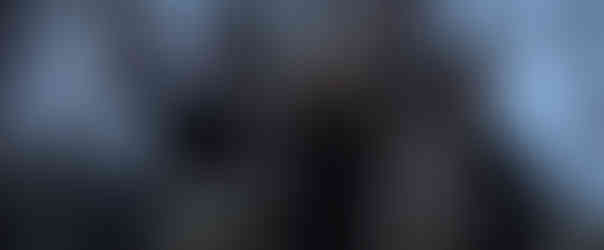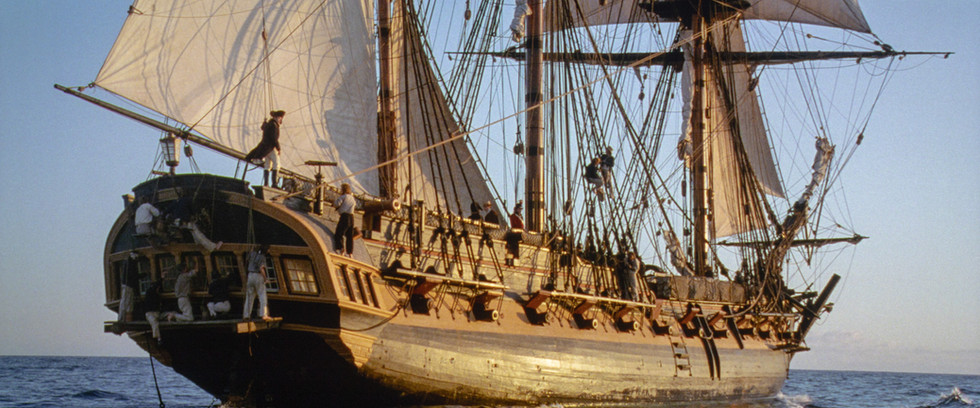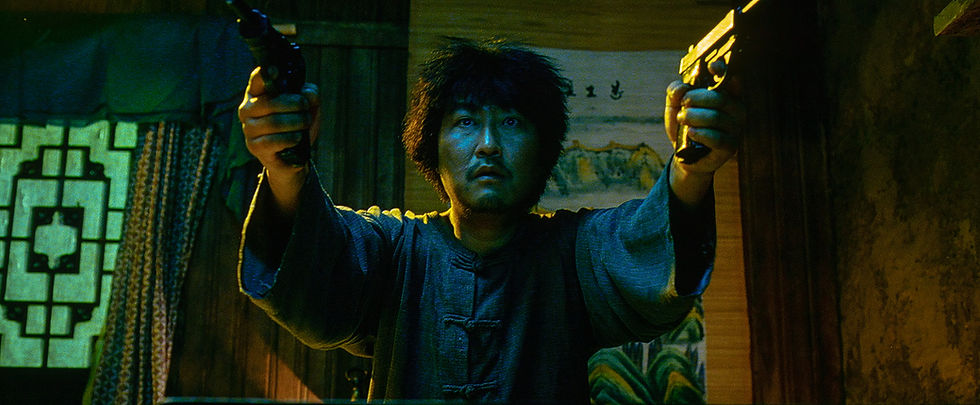Sail the high seas with Peter Weir’s “Master and Commander: The Far Side Of The World”
- Bill Kelley III

- Aug 8
- 7 min read
4K ULTRA HD REVIEW / HDR SCREENSHOTS
Fresh off his roles in “Gladiator” and “A Beautiful Mind,” Russell Crowe plays Captain John “Lucky Jack" Aubrey of the Royal Navy frigate HMS Surprise. The British ship was badly damaged by a surprise attack from the French privateer Acheron, bound for the Pacific. Aubrey and his men are to pursue and destroy the much larger Acheron.
(Click an image to scroll the larger versions)

“MASTER AND COMMANDER: THE FAR SIDE OF THE WORLD”
4K Ultra HD & Blu-ray; 2003; PG-13 for intense battle sequences, related images, and brief profanity; Digital copy via Amazon Video (4K), Apple TV (4K), Fandango Home (4K), Movies Anywhere (4K), YouTube (4K)
Best extra: “The Hundred Days” making of documentary (Digital only)
FOR DECADES, director Peter Weir has been one of my favorite filmmakers. His filmography covers a wide range of cinematic emotions, from thrillers, mysteries, war films, survival stories, domestic dramas, romantic and dark comedies, thought-provoking satires, and action epics.
His success began in the early 1970s as he helped inflame the Australian New Wave cinema, which included the haunting mystery “Picnic at Hanging Rock” (1975) and “The Last Wave” (1977). Next came two war films, “Gallipoli” (1981) and “The Year of Living Dangerously” (1982), both starring Mel Gibson.
Weir then moved to America and instantly became one of Hollywood’s new stars. “Witness” (1985) was his first, receiving eight Oscar nominations, including Best Picture and his first nod as Best Director. Harrison Ford played a Philly homicide detective who hides out in Amish country to protect a young witness.
Weir and Ford collaborated again with the under-performed “The Mosquito Coast” (1986). Succeeding was Weir’s coming-of-age crowd pleaser “Dead Poets Society” (1989) which Robin Williams received an Oscar nod for Best Actor, and Weir was again nominated for Best Director.
His next project would be considered his least popular film, “Green Card” (1990), in which a Frenchman and an American woman, played by Andie MacDowell, pretend to marry, so Gérard Depardieu can stay in the U.S.
Possibly his most underrated film, “Fearless” (1993), stars Jeff Bridges who wrestles with his survival of a fatal airliner crash with another survivor played by Rosie Perez.
Then, the wonderful social commentary “The Truman Show” (1998) arrived. Weir received his third Best Director nomination, as Jim Carrey plays an imprisoned reality TV character, Truman Burbank.
(1) “Master and Commander: The Far Side of the World” was a moderate box office success when it premiered on November 14, 2003. (2-4) It’s early morning in the Atlantic, and right, Midshipman Hollmon (Lee Ingleby) thinks he sees a shadow in the fog. Capt. Aubrey double-checks, and then a red flash. (5-6) After a violent battle, Aubrey searches for the French Acheron, and coxswain Barrett Bonden (Billy Boyd) discovers the rutter has been destroyed. (7) The ship surgeon Stephen Maturin (Paul Bettany) operates on an injured crewmember. (8) Aubrey decides to tow the Surprise into a fog bank with two rowboats.
AND FINALLY, arriving on 4K Ultra HD is Weir’s 10-Academy Award-nominated “Master and Commander: The Far Side of the World,” based on two of 20 Patrick O’Brian’s novels of 19th-century sea adventures.
Captain Jack Aubrey (Russell Crowe), his ship surgeon Stephen Maturin (Paul Bettany), and crew of the HMS Surprise are on a mission to hunt down the Acheron, a French vessel that attacked the outgunned British ship in 1805. They will pursue their rival rounding Cape Horn during an intense storm, into Pacific waters and the Galapagos Islands, where naturalist Maturin hopes to explore.
The late Chicago Sun-Times film critic Roger Ebert said in his review, “There are scenes at sea, including the rounding of Cape Horn, which are as good or better as any sea journey ever filmed.” Ebert, who co-hosted the weekly TV show “At the Movies,” stated, “‘Master and Commander’ is grand and glorious, and touching in its attention to its characters. Like the work of David Lean (“Lawrence of Arabia”), it achieves the epic without losing sight of the human.”
EXTRAS
Not a single extra is included on the 4K disc, which was mysteriously changed from a larger 100 GB disc, stated in Disney’s press release earlier this summer, to the smaller 66 GB disc. Some speculate that the production of the smaller disc is easier, which would allow Sony, that handles the stamping and distribution, could provide more copies for buyers. Still, the Steelbook Edition sold out before its 4K launch.
The few bonus features are included on the 2012 carryover Blu-ray included in the Steelbook. Those are just a small sample of what was made available on the 2004 Special Edition DVD. Thankfully, those added valued extras are available on the digital code copy.
“The Hundred Days” (2003, 68 mins.) – provides detailed accounts of the extremely difficult production, with interviews from Weir and the cast. The director was offered “Master and Commander” from producer Tom Rothman, who told the director, “I’m not gonna pitch you a story. I’m gonna give you a gift.” The story goes, Rothman left the room and returned with a sword. And, Weir said, “O’Brian?” And the producer responded, “Yes, I want you to take command.”
Weir admits he had already turned down one option to direct an O’Brian tale. “I don’t think it’d make a great movie,” he told Rothman. “I love the series, and read them all, but if I were doing it, I’d start somewhere in the middle with one of the long voyages.” That’s exactly what he did, focusing on book No. 10 to create this extraordinary epic.
“In the Wake of O’Brian” (2003, 20 mins.) – Weir details his research, from visiting a number of antique shops, the Greenwich Museum, home of the British Naval history, walking the deck of the HMS Victory dry docked in Portsmouth, and taking a number of sea travels, which prepared him for the scriptwriting sessions. He continuously played period music in the background to set the mood.
Three 2003 featurettes: “Cinematic Phasmids” (30 mins.) – details the special effects from computer-generated VFX, models, and full-size warships. “On Sound Design” (18 mins.) – provides insights into the Oscar-winning sound design by Richard King. “HBO First Look” (25 mins.) – with cast interviews, including behind-the-scenes footage of the replica ship built on a gimbal system inside the huge water tank in Mexico, originally used for production of “Titanic.”
“Multi-Camera Shoots” shows a number of camera angles, B-Roll, and Composite.
“Still Galleries” – Conceptual art, Naval art, Technical drawings.
“Trailers” – Teaser, Theatrical, and International.
“Historical and Geographic Trivia Track” – dozens of pop-up factoids are available on the Blu-ray and digital.
Deleted Scenes – 24 additional minutes from six scenes, available on Blu-ray and digital.
VIDEO
The folks at 20th Century Studios scanned the original 35mm camera negative elements, captured in the Super 35 format from Oscar-winning cinematographer Russell Boyd (“Picnic at Hanging Rock,” “Gallipoli”). Individual frames were remastered in TRUE 4K. The digital effects, originally rendered in 2K, were upconverted to 4K, and those moments show a lesser resolution compared to the original negative. Now, the film grain is much more refined and detailed compared to the 2K mastered Blu-ray.
With the smaller 66 GB disc, the video bitrate runs a good 20 Megabits per second less than if it had been encoded onto a 100 GB disc. It ends up averaging in the mid-40 Mbps range and shows no signs of artifacts. The intense sequence of the HMS Surprise rounding Cape Horn struggles with clarity, with its multi-layer effects. But, the clear daylight scenes, especially on the Galapagos Islands and below-deck scenes, are quite striking with their HDR10 and Dolby Vision grading with deep, dark blacks. The overall color palette has been slightly desaturated, but the facial toning is very natural with its diverse cast.
AUDIO
The previous DVD and six-channel DTS-HD Blu-ray was once considered reference-level sound quality. The now-defunct Sound and Vision Magazine gave “Master and Commander” in the early 2000s, the highest recommendations for its demo deep bass response and sound effects.
Now, with its new Dolby Atmos track, the sound level is 4 dB lower than the older discs, which has become the standard for Disney discs. To resolve, I just increased the volume on my AV receiver. Also, the bass response is not as deep, rolling off around 50-hertz during the cannon blasts (previously sub-30Hz), but overall, with the added height-speaker sound effects, it puts you right inside the action.
This 4K release is the third Disney/Sony release in just a few months. Since 2020, Disney’s library of older films (20th Century Studios, Touchstone) has been kept in cold storage without any sign of 4K Ultra HD releases. Then last year, Sony partnered with Disney to handle their physical discs, and the vault door began to see the light of day. First to arrive was the Western classic “Tombstone,” then Ridley Scott’s sword and sandal epic “Kingdom of Heaven: Director’s Cut,” and now “Master and Commander.”
All three had been suggested to Disney by Digitabits.com founder and editor Bill Hunt, who submitted his top 50 titles needing a 4K release from Disney. He also provided another 50 titles, so Disney/Sony, you have a lot of work ahead to fill the home theaters of 4K disc lovers.
Keep up the good work!
— Bill Kelley III, High-Def Watch producer
SPECS:
66 GB disc
True 4K mastering
Video bitrate average: 44.85 Megabits per second, with a running time of 2 hours 18 minutes
3-perf 35mm Super 35 format, 2.39:1 aspect ratio
HDR10 maximum light level: 986 nit
Max frame average light level: 821 nit
Academy Awards: 10 nominations, including Best Picture, Best Director, Best Film Editing, Best Art Direction, Best Costume Design, Best Makeup, Best Sound Mixing, Best Visual Effects, and won Two Oscars: Best Cinematography and Best Sound Editing.
Box Office: $93 million domestically, and worldwide $211.6 million, with a production budget of $150 million. It finished the year as the 21st biggest box office movie, and No. 1 was Peter Jackson’s “The Lord of the Rings: The Return of the King,” which won 11 Oscars.
































































Comments